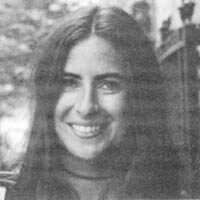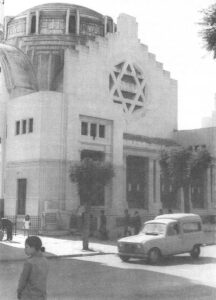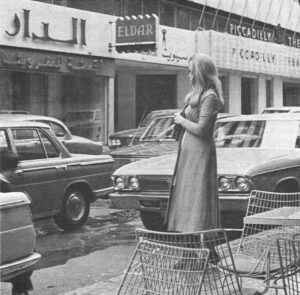Paula Stern
- 1970

Fellowship Title:
- The Contemporary Middle East
Fellowship Year:
- 1970

Obituary for a People: The Jews of Tunisia I
* Names have been changed to respect certain individuals’ anonymity. May, 1971 The best way to understand the past and present of the Maghreb is to regard it through the prism of the history of its Jews. Among all the races of the Maghreb today, only the Jews, while retaining their own identity, have known the long series of empires that governed this territory from the Phoenicians to the French. …Every Jewish community in North Africa formed a microcosm in which it was possible not only to observe at first hand an ancient heritage that had been faithfully preserved but also the rapid transition from a civilization based on the Arab Middle Ages to one that is part of twentieth century France or Israel… Thus, the history of mankind may often be summed up in the changes that have overtaken one community, one family, and one man. –From Andre Choraqui,Between East and West, The Jews of North Africa, 1969 The Zionist Of Sidi Bou Said Felix wanted to show off his battle scars from the
Ibrihim Thinks About Israel*
March, 1971 *In my first newsletter, my first newsletter for the Alicia Patterson Fund. Uri Avnieri, Member of Knesset (Israel’s Parliament) was interviewed on the subject of Palestine. This newsletter is the second in a series which aims to demonstrate the existence of a plurality of opinion on both sides of the Middle East cease-fire line. The person granting this interview wishes to remain anonymous. Publicly, he identifies himself as a spokesman for Al Hurriah, the organ of the Democratic Pooular front for the Lioeration of Palestine, the farthest left Palestine commando organization. The tall, dark – and yes – handsome Arab with bushy, black hair and moustache and penetrating brown eyes was dressed entirely in black. He looked mysterious. Yet he – call him Ibrihim – was friendly and open. Ibrihim was anxious to share his ideas about the Middle East, which he cultivated in his homeland of Lebanon and in his recent studies in England. At a seaside Beirut restaurant, he launched into a three hour long “rap” session for two rapt comrades. He
Palmyra: Through a Veil Darkly
February 1971 A visit to Palmyra, Syria, where Queen Zenobia, one of the greatest women in history, once ruled an empire stretching from Asia Minor to Egypt, is enough to discourage even the most dedicated women’s liberation activist. Women in Palmyra have come a long way since the Third Century A.D. when one of their sex ruled a queendom that challenged even the Romans. But it seems they have gone most of their way in reverse. Queen Zenobia may be an attractive symbol for women’s liberation in the Western world, but her soul sisters in Palmyra do not appear to care. Indeed, in public, women do not appear at all – even during the prime social hour, early evening. In this oasis town in the Syrian desert, the dozen or so ahwes (a cross between cafe and men’s social club) are filled with Arab men sipping Turkish coffee, talking and playing backgammon. Meanwhile, except perhaps for a young girl with her grandfather or an elderly woman, a female never goes out at night. Most of

Tamam of Ain Kfar Zabed, Lebanon
January 1971 The Mukhtar’s baby sister has mother-in-law problems. In-law problems are not unknown in Ain Kfar Zabed, but the case of Tamam Sarkis has an unusual twist. The problem with Tamam is that she has been taught to think. Tamam has spent six years under the tutelage of Mademoiselle Antoinette, the Directress of a vocational school for girls in the village. Tamam has learned needlework – embroidery, knitting, and crocheting and “to do needles,” which in colloquial Arabic means to administer a shot. Tamam is a nurse’s aid, the only salary-earning female in the village. Mademoiselle Chidiac (right) and Madame Samira, the dressmaking instructress. Both commute to the village from the city of Zahle. Twelve years ago, Tamam’s mentor, Antoinette Chidiac, “doing a Christian deed,” came to Ain Kfar Zabed by donkey, the only means of transportation until a road was built five years ago. She chose the village for her charitable enterprise because she had heard it was the poorest around. Six years ago, she established, with the assistance of the Lebanese Government’s

The Village of Beirut
December 1970 Hamra is a cross between Main Street, U.S.A., and Rome’s Via Venetto plus more neon, bazazz, and clamor. Signs are in English or Arabic transliteration – not translation – of the English reads “Splendid Store;” and its “Famous Hamburgers.” Girls flutter by in Paris’ latest fashions (except if it is after eight at night when few respectable Lebanese females go in public unescorted). Even in early winter coats are unnecessary. Minis – not just short skirts but honest- to-goodness minis predominate. A few clotheshounds swelter in Europe’s winter midis. Fashionable men wear tight fitting pants and bodyhugging patterned shirts. Hamra traffic is always congested. Motorists’ eyes wander from the road to the sidewalk parade of minis. And cabbies spotting a potential fare slow down and toot their horns. Since Hamra is full of promenaders, everyone could be a customer; and the result is an endless stream of pure, unadulterated noise. (One amateur anthropologist speculated that this cacophony results from Beirutis demonstrating they have become citified and left the quiet desert behind. The minarets
